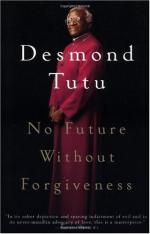
|
| Name: _________________________ | Period: ___________________ |
This test consists of 15 multiple choice questions and 5 short answer questions.
Multiple Choice Questions
1. What type of justice did South Africa use in the Promotion of National Unity and Reconciliation Act?
(a) Restorative justice.
(b) Retributive justice.
(c) Quick justice.
(d) Mob justice.
2. How many people sent their statement that they wanted recorded?
(a) 20,000.
(b) 30,000.
(c) 40,000.
(d) 50,000.
3. How old was Nelson Mandela in 1994?
(a) 76 years old.
(b) 56 years old.
(c) 75 years old.
(d) 66 years old.
4. What did people with ties to the segregationist regime get for their confession?
(a) A light sentence.
(b) The right to leave the country
(c) Amnesty.
(d) Their lives spared.
5. What was the TRC in charge of providing according to "Chapter Six, A Victim Hearing"?
(a) A complete picture of human rights violations.
(b) A scapegoat.
(c) Power to black people.
(d) The illusion of fairness.
6. What does Tutu say Mandela thought the reconciliation had to be?
(a) Quick.
(b) Headed by black people.
(c) Spiritual.
(d) Headed by white people.
7. Tutu stated the South African regime was _____________.
(a) Bureaucratic.
(b) Pigmentocratic.
(c) Autocratic.
(d) Democratic.
8. Where did the former segregationists live in 1994 according to Tutu?
(a) Still in South Africa.
(b) In Mozambique.
(c) In Europe.
(d) In South America.
9. What could Apartheid supporters not plead according to Tutu?
(a) Ignorance.
(b) Innocent.
(c) Quilty.
(d) No contest.
10. What does Tutu think would have happened if the prime minister had not rescinded the ban of reform organizations?
(a) Nothing.
(b) A bloodbath.
(c) A victory for the white parties.
(d) A large turn out of voters.
11. What type of justice do most people inherently think of?
(a) Mob justice.
(b) Retributive justice.
(c) Quick justice.
(d) Restorative justice.
12. Tutu said the TRC spoke for ______________.
(a) White people.
(b) Black people.
(c) The victims.
(d) The oppressors.
13. Why were the unarmed schoolchildren shot and killed during the Soweto violence in 1976?
(a) For looting.
(b) For protesting.
(c) For going to school.
(d) For not saluting the flag.
14. Tutu alerted the Anglican Communion of ______________.
(a) Whites not communing.
(b) Racist preachers.
(c) Non believers in the TRC.
(d) A need for prayer.
15. What political event does Tutu speculate could have helped prevent bloodshed?
(a) The disbanding of the ANC.
(b) The fall of communism.
(c) The rise of capitalism.
(d) The rise of Mandela.
Short Answer Questions
1. What does Tutu say the trials under Promotion of National Unity and Reconciliation Act ensured?
2. What did Tutu have to do before becoming the Dean of Johannesburg?
3. According to Tutu, the ANC was not merely ______________.
4. What was December 16th designated as prior to 1994?
5. Who composed the ANC as of 1994?
|
This section contains 440 words (approx. 2 pages at 300 words per page) |

|




